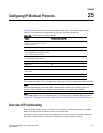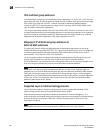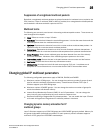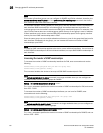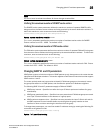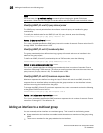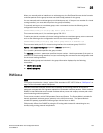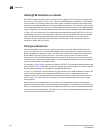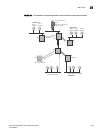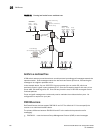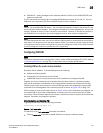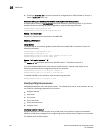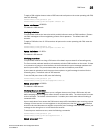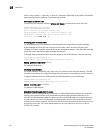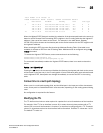
734 PowerConnect B-Series FCX Configuration Guide
53-1002266-01
PIM Dense
25
Initiating PIM multicasts on a network
Once PIM is enabled on each router, a network user can begin a video conference multicast from
the server on R1 as shown in Figure 120. When a multicast packet is received on a PIM-capable
router interface, the interface checks its IP routing table to determine whether the interface that
received the message provides the shortest path back to the source. If the interface does provide
the shortest path back to the source, the multicast packet is then forwarded to all neighboring PIM
routers. Otherwise, the multicast packet is discarded and a prune message is sent back upstream.
In Figure 120, the root node (R1) is forwarding multicast packets for group 229.225.0.1, which it
receives from the server, to its downstream nodes, R2, R3, and R4. Router R4 is an intermediate
router with R5 and R6 as its downstream routers. Because R5 and R6 have no downstream
interfaces, they are leaf nodes. The receivers in this example are those workstations that are
resident on routers R2, R3, and R6.
Pruning a multicast tree
As multicast packets reach these leaf routers, the routers check their IGMP databases for the
group. If the group is not in a router IGMP database, the router discards the packet and sends a
prune message to the upstream router. The router that discarded the packet also maintains the
prune state for the source, group (S,G) pair. The branch is then pruned (removed) from the
multicast tree. No further multicast packets for that specific (S,G) pair will be received from that
upstream router until the prune state expires. You can configure the PIM Prune Timer (the length of
time that a prune state is considered valid).
For example, in Figure 120 the sender with address 207.95.5.1 is sending multicast packets to the
group 229.225.0.1. If a PIM switch receives any groups other than that group, the switch discards
the group and sends a prune message to the upstream PIM switch.
In Figure 121, switch S5 is a leaf node with no group members in its IGMP database. Therefore, the
switch must be pruned from the multicast tree. S5 sends a prune message upstream to its
neighbor switch S4 to remove itself from the multicast delivery tree and install a prune state, as
seen in Figure 121. Switch S5 will not receive any further multicast traffic until the prune age
interval expires.
When a node on the multicast delivery tree has all of its downstream branches (downstream
interfaces) in the prune state, a prune message is sent upstream. In the case of S4, if both S5 and
S6 are in a prune state at the same time, S4 becomes a leaf node with no downstream interfaces
and sends a prune message to S1. With S4 in a prune state, the resulting multicast delivery tree
would consist only of leaf nodes S2 and S3.




